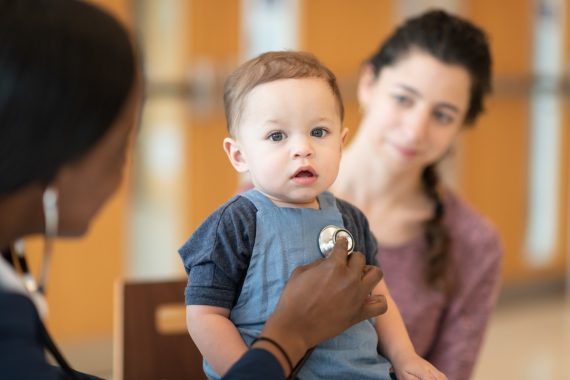Oxygen sats threshold no longer automatic trigger for emergency bronchiolitis referral

NICE has updated its guidance on diagnosis and management of bronchiolitis in children after reviewing evidence on oxygen saturation thresholds for referral to hospital.
The committee changed a 2015 recommendation that an oxygen saturation level of less than 92% should trigger immediate transfer to hospital to that it ‘requires consideration’ of hospital referral along with other symptoms.
On reviewing the latest evidence, the committee felt that the 92% oxygen saturation threshold alone was not enough to justify calling an ambulance.
But emergency hospital transfer should be made for babies and children with apnoea, who look seriously unwell to the healthcare professional, are in severe respiratory distress or have central cyanosis.
The change in emphasis may lead to a small increase in the number of children and babies being immediately sent to hospital for meeting one of these criteria as previously some were not referred if they did not also meet the <92% oxygen saturation threshold, the committee said.
They noted that oxygen saturation level alone can still be used to justify referral on the clinical judgement of the healthcare professional, but it is no longer an automatic reason for calling an ambulance.
One aspect the committee took into account is that measurement in primary care may not be as accurate as in hospital because paediatric oximeters are often not available, NICE said.
The committee also pointed out that it is unlikely for a baby or child to have an oxygen saturation level of less than 92% but none of the other criteria for immediate referral, so seriously unwell babies and children will still be sent to hospital as an emergency.
But more research is needed on the clinical and cost effectiveness of oxygen saturation levels in primary care for children and babies with bronchiolitis, the committee said.
The guidance also flags up a 2018 NHS England patient safety alert on the risk of harm from inappropriate placement or use of pulse oximeter probes, such as using adult probes on children.
Hospitals also received updated guidance with a new oxygen saturation threshold for admission, management and discharge of bronchiolitis to less than 90% for all children except babies under 6 weeks old and those with underlying health conditions.
Click to complete relevant Respiratory CPD modules on Pulse Learning.
Visit Pulse Reference for details on 140 symptoms, including easily searchable symptoms and categories, offering you a free platform to check symptoms and receive potential diagnoses during consultations.
Related Articles
READERS' COMMENTS [6]
Please note, only GPs are permitted to add comments to articles










I don’t know how much more of this I can take
So treating numbers is a no no now? Who knew?
Noctors will be up in arms….
I just don’t know how the human race survived before probes.
Funny: who’d have thought doctors needed to be told that a blue apnoeic baby needed to go to hospital?
quangos have to justify themselves
I still don’t see any reason for any “emergency” GP appointment, bypassing ED, 111 and a paramedic. That old knee jerk casual saying by the public, “I need an emergency appointment” _ don’t we all. And you pay out of your salary for the oxygen tank refill, which has always bemused me.